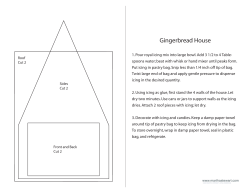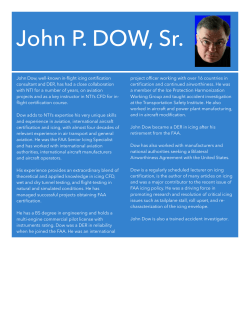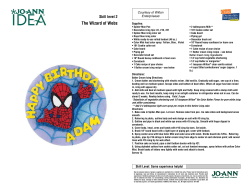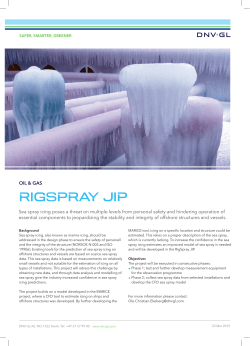
Corrigendum to Decision 2015/008/R
25 March 2015 CORRIGENDUM Corrigendum to Decision 2015/008/R of the Executive Director of the Agency of 12 March 2015 amending Decision No 2003/002/RM of the Executive Director of the Agency of 17 October 2003 on Certification Specifications and Acceptable Means of Compliance for Large Aeroplanes (‘CS-25’) ‘CS-25 – Amendment 16’ CS 25.1521 (page 1–G–2) has been amended as follows: SUBPART G – OPERATING LIMITATIONS AND INFORMATION CS 25.1521 Powerplant limitations … (c)… (3) Maximum time interval between engine run-ups from idle, run-up power setting, duration at power, and the associated minimum ambient temperature, if any, demonstrated for the maximum time interval, for ground operation in icing conditions, as defined in CS 25.1093(b)(2). (34) Any other parameter for which a limitation has been established as part of the engine type certificate except that a limitation need not be established for a parameter that cannot be exceeded during normal operation due to the design of the installation or to another established limitation. CS 25.1533 (page 1–G–3) has been amended as follows: CS 25.1533 Additional operating limitations … (c) For aeroplanes certified in accordance with CS 25.1420(a)(1) or (a)(2), an operating limitation must be established to: (1) Prohibit intentional flight, including take-off and landing, into icing conditions defined in Appendix O for which the aeroplane has not been certified to safely operate; and (2) Require exiting all icing conditions if icing conditions defined in Appendix O are encountered for which the aeroplane has not been certified to safely operate. CS 25J1093(a) (page 1-J-6) has been amended as follows: SUBPART J – AUXILIARY POWER UNIT INSTALLATIONS CS 25J1093 Air intake system icing protection (a) Each non-essential APU air intake system, including any screen if used, which does not comply with CS 25J1093(b) will be restricted to use in non-icing conditions, unless it can be shown that the APU complete with air intake system, if subjected to the icing conditions defined in Appendices C, O and P, will not affect the safe operation of the aeroplane. 1 CS 25J1093(b) has been replaced by the following text: CS 25J1093 Air intake system icing protection … (b) For essential APUs: Each essential APU, with all icing protection systems operating, and screen if used, must: (1) operate throughout its flight power range in the icing conditions defined in Appendices C, O and P, and in falling and blowing snow within the limitations established for the aeroplane for such operation, without the accumulation of ice on the APU, air intake system components or airframe components that would do any of the following: (i) Adversely affect installed APU operation or cause a sustained loss of power; or an unacceptable increase in gas path operating temperature; or an airframe/APU incompatibility; or (ii) Result in unacceptable temporary power loss or APU damage; or (iii) Cause a stall, surge, or flameout or loss of APU controllability (for example, rollback). (2) operate for a minimum of 30 minutes on the ground in the icing conditions shown in Table 1 of CS 25.1093(b)(2), unless replaced by similar test conditions that are more critical. These conditions must be demonstrated with the available icing protection (if applicable) at its critical condition, without adverse effect. The applicant must document the APU minimum ambient temperature demonstrated, if any, and establish the aeroplane operating limitations. Appendix C, Part II (page 1–App C–1) has been amended as follows: APPENDIX C Part II - Airframe Ice Accretions for Showing Compliance with Subpart B (a) Ice accretions - General … (1) Take-off Ice is the most critical ice accretion on unprotected surfaces, and any ice accretion on the protected surfaces appropriate to normal ice protection system operation, occurring between lift-off the end of the take-off distance and 122 m (400 ft) above the take-off surface, assuming accretion starts at lift-off the end of the take-off distance in the take-off maximum icing conditions of Part I, paragraph (c) of this Appendix. (2) Final Take-off Ice is the most critical ice accretion on unprotected surfaces, and any ice accretion on the protected surfaces appropriate to normal ice protection system operation, between 122 m (400 ft) and either 457 m (1 500 ft) above the take-off surface, or the height at which the transition from the takeofftake-off to the en route configuration is completed and VFTO is reached, whichever is higher. Ice accretion is assumed to start at liftoff the end of the take-off distance in the take-off maximum icing conditions of Part I, paragraph (c) of this Appendix. … (d) … (2) The ice accretion starts at lift-off the end of the take-off distance; … 2 AMC – SUBPART F AMC No. 1 to CS 25.1329 Flight Guidance System The table related CS standards (page 2-F-105) has been amended as follows: … 2 RELATED CERTIFICATION SPECIFICATIONS CSs The following are related CS standards: CS 25.115 Take-off flight path CS 25.302 Interaction of systems and structures CS 25.671 Control systems, General CS 25.672 Stability augmentation and automatic and power-operated systems CS 25.677 Trim systems CS 25.777 Cockpit controls CS 25.779 Motion and effect of cockpit controls CS 25.781 Cockpit control knob shape CS 25.901 Powerplant, General, Installation– CS 25.903 Powerplant, General, Engines CS 25.1301 Equipment, General, Function and installation– CS 25.1309 Equipment, systems, and installations CS 25.1322 Warning, caution, and advisory lights Flight Crew Alerting System CS 25.1419 Ice protection CS 25.1420 Supercooled large drop icing conditions CS 25.1581 Aeroplane Flight Manual, General CS-AWO All Weather Operations The title of AMC 25J1093(b) (page 2–J–2) has been updated as follows: AMC 25J1093(b) Essential APU Air IntakesEssential APU air intake system de-icing and anti-icing provisions … 3
© Copyright 2025











